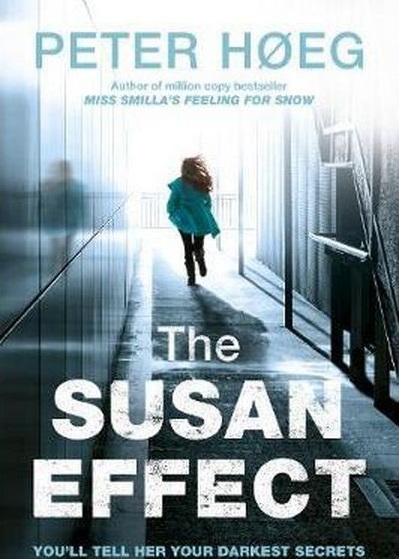Peter Høeg: The Susan Effect review - Nordic noir turns surreal | reviews, news & interviews
Peter Høeg: The Susan Effect review - Nordic noir turns surreal
Peter Høeg: The Susan Effect review - Nordic noir turns surreal
Conspiracy thriller from the 'Miss Smilla' author mixes physics and superpowers

Peter Høeg is still overwhelmingly known for a novel published a quarter of a century ago. Miss Smilla’s Feeling for Snow featured a half-Inuit woman whose suspicion over a young neighbour’s death in Copenhagen lures her from Denmark back to Greenland.
Miss Smilla was a globe-trotting precursor to Nordic noir, softening us all up for the amped-up stories of skulduggery in the senior echelons of the Danish state. (Borgen was the smiley, soothing antidote.) He’s back on similar territory in The Susan Effect. Once more there’s a conspiracy, a secret island where murky things happen, and murder is covered up – though not just the one this time.
The narrator is Susan Svendsen, a super-talented physicist married to a much loved composer called Laban (meaning scamp). They have 16-year-old twins, Harald and Thit. When we first encounter the family they’re all in a spot of bother after a series of misadventures in South Asia. Laban is being chased by the Indian mafia after seducing a maharaja’s daughter. Harald has been smuggling antiquities out of Nepal. Thit has run off with a priest from Kolkata. As for Susan, she’s in prison for causing grievous bodily harm to a casual pick-up.
A mysterious former representative of the Danish government called Thorkild Hegn intervenes to get them off the hook if Susan will in return do a little job for him: find out about something called the Future Commission. Back in Copenhagen, Susan embarks on her task only to discover that asking anyone about the Future Commission induces silence, terror and, intermittently, murder. She and Harald barely escape death, leaping from their car just before it’s crushed.
 Nordic noir often features cold-blooded Scandinavians keeping a cool head, their chilliness a necessary counterpoint to a lot of hot-headed derangement. Think of all the villains in The Bridge, or the nutters who cross the path of Harry Hole in Jo Nesbø’s policiers. Insane megalomaniacs, the lot. There are more here too, going all the way to the top of Danish society. Høeg interposes his own twist in the form of the Svendsen family, who all possess one superpower or another. Laban can charm crowds into a trance, Harald has "a memory like flypaper", Thit cracks computer passwords for fun, while the eponymous effect makes those who come within Susan's orbit vulnerable to bursts of uncontrollable openness. It means she can extract the truth without thumbscrews.
Nordic noir often features cold-blooded Scandinavians keeping a cool head, their chilliness a necessary counterpoint to a lot of hot-headed derangement. Think of all the villains in The Bridge, or the nutters who cross the path of Harry Hole in Jo Nesbø’s policiers. Insane megalomaniacs, the lot. There are more here too, going all the way to the top of Danish society. Høeg interposes his own twist in the form of the Svendsen family, who all possess one superpower or another. Laban can charm crowds into a trance, Harald has "a memory like flypaper", Thit cracks computer passwords for fun, while the eponymous effect makes those who come within Susan's orbit vulnerable to bursts of uncontrollable openness. It means she can extract the truth without thumbscrews.
The Svendsens are in essence a brainiac version of the Incredibles, minus the branded superhero livery. Their specialness makes for some playful surrealism, but plotwise it’s also a get-out-jail card – sometimes literally. Perhaps fearful that all these superpowers look infantile, Høeg’s trick for occluding any cracks in plausibility is to make Susan a kind of empirical rationalist with an explanation for everything based in physics. “People are small next to physics,” she explains. She would say that, being the disciple of a disciple of Nils Bohr (this is a homage in passing to great Danes, so there’s a lot of name-dropping: at one point Susan has a one-to-one with Gorbachev). “In quantum physics,” she tells Laban, whom she has sexually betrayed roughly once a year throughout their marriage, “we say that divorcing from a profound romantic relationship takes seven years on average.” The cloak of pseudo-nerdery is not always as dazzling as the author intends. The same law of diminishing returns applies to the many throat-clearing digressions and retroactive tangents. It means that Susan and her family are rather hard to know, and harder to like.
Meanwhile, as her investigations proceed, a conspiracy unfurls in which cynicism about the dark state meshes with a throwback plot about nuclear apocalypse. The Future Commission turns out to be a body established in the early 1960s composed of prodigiously bright people whose pooled talents established a practical basis for predicting the future. Susan is a resourceful action heroine, part Lisbeth Salander, part Saga Norén, fearless with a crowbar and a screwdriver. But her effect on this reader was not wholly overpowering.
- The Susan Effect by Peter Høeg, translated by Martin Aitken, is published by Harvill Secker on 3 August
- More book reviews on theartsdesk
The future of Arts Journalism
You can stop theartsdesk.com closing!
We urgently need financing to survive. Our fundraising drive has thus far raised £49,000 but we need to reach £100,000 or we will be forced to close. Please contribute here: https://gofund.me/c3f6033d
And if you can forward this information to anyone who might assist, we’d be grateful.

Subscribe to theartsdesk.com
Thank you for continuing to read our work on theartsdesk.com. For unlimited access to every article in its entirety, including our archive of more than 15,000 pieces, we're asking for £5 per month or £40 per year. We feel it's a very good deal, and hope you do too.
To take a subscription now simply click here.
And if you're looking for that extra gift for a friend or family member, why not treat them to a theartsdesk.com gift subscription?
more Books
 'We are bowled over!' Thank you for your messages of love and support
Much-appreciated words of commendation from readers and the cultural community
'We are bowled over!' Thank you for your messages of love and support
Much-appreciated words of commendation from readers and the cultural community
 Thomas Pynchon - Shadow Ticket review - pulp diction
Thomas Pynchon's latest (and possibly last) book is fun - for a while
Thomas Pynchon - Shadow Ticket review - pulp diction
Thomas Pynchon's latest (and possibly last) book is fun - for a while
 Justin Lewis: Into the Groove review - fun and fact-filled trip through Eighties pop
Month by month journey through a decade gives insights into ordinary people’s lives
Justin Lewis: Into the Groove review - fun and fact-filled trip through Eighties pop
Month by month journey through a decade gives insights into ordinary people’s lives
 Joanna Pocock: Greyhound review - on the road again
A writer retraces her steps to furrow a deeper path through modern America
Joanna Pocock: Greyhound review - on the road again
A writer retraces her steps to furrow a deeper path through modern America
 Mark Hussey: Mrs Dalloway - Biography of a Novel review - echoes across crises
On the centenary of the work's publication an insightful book shows its prescience
Mark Hussey: Mrs Dalloway - Biography of a Novel review - echoes across crises
On the centenary of the work's publication an insightful book shows its prescience
 Frances Wilson: Electric Spark - The Enigma of Muriel Spark review - the matter of fact
Frances Wilson employs her full artistic power to keep pace with Spark’s fantastic and fugitive life
Frances Wilson: Electric Spark - The Enigma of Muriel Spark review - the matter of fact
Frances Wilson employs her full artistic power to keep pace with Spark’s fantastic and fugitive life
 Elizabeth Alker: Everything We Do is Music review - Prokofiev goes pop
A compelling journey into a surprising musical kinship
Elizabeth Alker: Everything We Do is Music review - Prokofiev goes pop
A compelling journey into a surprising musical kinship
 Natalia Ginzburg: The City and the House review - a dying art
Dick Davis renders this analogue love-letter in polyphonic English
Natalia Ginzburg: The City and the House review - a dying art
Dick Davis renders this analogue love-letter in polyphonic English
 Tom Raworth: Cancer review - truthfulness
A 'lost' book reconfirms Raworth’s legacy as one of the great lyric poets
Tom Raworth: Cancer review - truthfulness
A 'lost' book reconfirms Raworth’s legacy as one of the great lyric poets
 Ian Leslie: John and Paul - A Love Story in Songs review - help!
Ian Leslie loses himself in amateur psychology, and fatally misreads The Beatles
Ian Leslie: John and Paul - A Love Story in Songs review - help!
Ian Leslie loses himself in amateur psychology, and fatally misreads The Beatles
 Samuel Arbesman: The Magic of Code review - the spark ages
A wide-eyed take on our digital world can’t quite dispel the dangers
Samuel Arbesman: The Magic of Code review - the spark ages
A wide-eyed take on our digital world can’t quite dispel the dangers
 Zsuzsanna Gahse: Mountainish review - seeking refuge
Notes on danger and dialogue in the shadow of the Swiss Alps
Zsuzsanna Gahse: Mountainish review - seeking refuge
Notes on danger and dialogue in the shadow of the Swiss Alps

Add comment